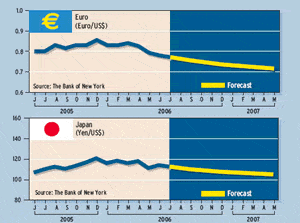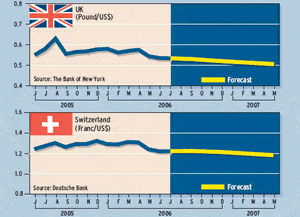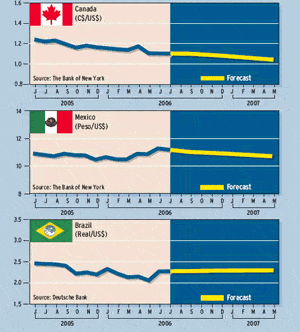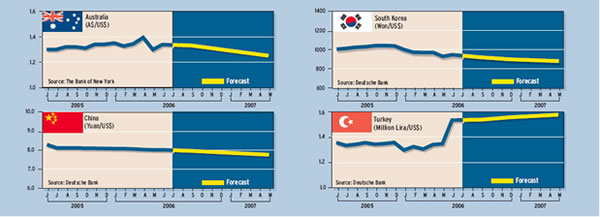One of the first things Paulson will do as treasury secretary will be to set the record straight on US dollar policy, says Carl Weinberg, chief economist at High Frequency Economics, based in Valhalla, New York. We believe that swapping Henry Paulson for John Snow may make a significant difference to the course of the US dollar over his tenure at Treasury, Weinberg says. In particular, we expect secretary Paulson to push the famous strong dollar policy with a degree of vigor and energy that Dr. Snow could never muster, he says.
Coming from the world of industry, Snow acted more like a commerce secretary than a treasury secretary, Weinberg says. Snow believed that a strong dollar is not necessarily helpful to the export of goods, or to the industries that produce goods for sale overseas, he says.
In the world of Goldman Sachs, the business is selling US securities, Weinberg says. It is dependent on a strong and stable US dollar. This is why it was so easy for former treasury secretary Robert Rubin, also formerly of Goldman Sachs, to formulate and advocate the view that a strong dollar is in the best interest of the US, according to Weinberg. What Rubin understood was that the job of the treasury secretary is to be the first salesman of US securities, both at home and abroad, he says.
China is the largest single customer of US treasury securities, and Paulson understands that one does not grow ones business by angering ones largest customer, Weinberg says. So we expect Paulson to back away from Snows hard line on yuan revaluation because the interests of the US treasury market are not served by it, he says.
By talking the dollar up, Paulson can reinforce interest-rate fundamentals in favor of the dollar and push the dollar back toward the post-European-unification norm of $1.15 against the euro, Weinberg says.
Ashraf Laidi, chief currency analyst at New York-based MG Financial Group, says, Considering Paulsons Wall Street experience and credibility, we regard his appointment more of a defensive measure to prevent the dollars downturn from accelerating into an uncontrollable pace.
Former treasury secretaries with a Wall Street background, from William Simon of Salomon Brothers in 1974 to 1977, to Donald Regan of Merrill Lynch from 1981 to 1985 and Robert Rubin of Goldman Sachs from 1995 to 1999, have served during periods of dollar strength, Laidi says.


Marc Chandler, global head of currency strategy at Brown Brothers Harriman, based in New York, says that while the market likes one of their own for the post, Paulson may not have the same good fortune as his Wall Street predecessors at the Treasury. The administrations low public-approval rating may limit Paulsons degree of freedom, even if he had a strong mandate from President Bush, Chandler says. Economic policy in this administration is seen to be orchestrated from the White House itself, not Treasury, he says.
US dollar policy is unlikely to change, according to Chandler. Paulson is likely to follow the more than 10-year-old declaratory policy of saying that a strong dollar is in the US interest, he says. But given the lack of political will in the US and elsewhere to make the structural reforms that are understood as necessary, the currency market will have to bear the burden of the adjustment process, he asserts. As a result, he adds, there likely will be a strong dollar in word under Paulson but benign neglect in deed.

Further Federal Reserve tightening as the US economy slows is likely to sap the dollars strength, says David Gilmore, economist and partner at FX Analytics, based in Essex, Connecticut. Raising rates in a period of economic deceleration is quite negative for the dollar and equities, Gilmore says. Sure, for the initial tightening or two the dollar will do well, but by August this will turn against the dollar, as it usually does in periods of Fed overshooting on rates, he says.
Raising rates with weak economic data nipping at the heels of the Fed chairman is reminiscent of 1987, when Alan Greenspan was following Paul Volckers rate hikes with his own image-related rate increases, Gilmore says. Well, the dollar and stocks did not fare well then and will not now, he says.
As a new chairman, Ben Bernanke had to reinvent himself as an inflation hawk or forever lose the respect of financial markets, Gilmore says. So Bernanke served up what the image consultants recommended, he says. No mention of pause, no mention of overshooting at inflection points, and no mention of lagged effects from prior tightening. Markets essentially do not know what to make of the Fed, or how much sway Bernanke holds over the Federal Open Market Committee, Gilmore says. It is starting to look like the inmates, the FOMC members, are running the penitentiary, and not the warden, he says.
The dollars gains since mid-May appear to be largely a function of an unwinding of positions in emerging markets, commodities and equity markets in general, according to Chandler of Brown Brothers Harriman. Emerging markets took in about $33 billion in the first few months of this year, on top of more than $20 billion last year, he points out. Clearly, some of this money has been repatriated, he says.
Meanwhile, interest-rate differentials have widened in favor of the dollar, and the US yield curve as measured by the difference in yield on the two-year note and the 10-year note has become inverted. An inverted yield curve has tended to coincide with a stronger dollar, Chandler says.

Gordon Platt



